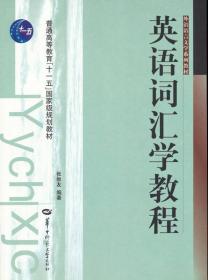
外语语言文学系列教材:英语词汇学教程
¥ 3 1.2折 ¥ 25 九品
仅1件
作者张维友 编著
出版社华中师范大学出版社
出版时间2004-02
版次2
装帧平装
上书时间2024-09-28
- 在售商品 暂无
- 平均发货时间 20小时
- 好评率 暂无
- 最新上架
商品详情
- 品相描述:九品
图书标准信息
- 作者 张维友 编著
- 出版社 华中师范大学出版社
- 出版时间 2004-02
- 版次 2
- ISBN 9787562216858
- 定价 25.00元
- 装帧 平装
- 开本 16开
- 纸张 胶版纸
- 页数 257页
- 字数 280千字
- 【内容简介】
-
《英语词汇教程》(以下简称《教程》)是笔者在多年实践的基础上整理而成的。《教程》在保留词汇学传统的知识结构基础上,尽可能融进本学科新的研究成果,着力反映词汇的新发展,并首次引进了篇章词汇语义学的内容。本书的着眼点在于实用,因此,理论上阐述深入浅出,删繁就简。同时博采例征,提供丰富的素材。该书配备了相当数量的练习题和思考题,以便巩固学习内容,学以致用。《教程》自1997年问世以来,深受广大师生的欢迎,先后重印六次。
21世纪到来,科学技术日新月异,信息知识瞬息万变。近几年来,词汇学领域出现了不少新的研究成果。为了紧跟时代步伐,与时俱进,笔者感到有必要对《教程》进行修订。本书把原第三章的某些内容独立成章,进行了重写。第二章新增两节,阐述当代英语的特征和发展趋势。对辞书部分进行了较大的改动,不仅增加了20世纪90年代未期和21世纪前三年出现的新辞书,还专辟一节详尽地介绍四部优秀词典,大增加了该书的时效性和实用价值。 - 【目录】
-
Chapter 1 The Basic Concepts of Words and Vocabulanr
1.1 The Definition of a Word
1.2 Vocabulary
1.3 Sound and Meaning
1.4 Sound and Form
1.5 Classification of Words
1.Basic Word Stock and Nonbasic Vocabulary
2.Content Words and Functional Words
3.Native Words and Borrowed Words
Questions and Tasks
Chapter 2 The Development of the English Vocabulary
2.1 The Indo-European Language Family
2.2 Three Phases of the Historical DeveloDment
1.Old English(450—1150)
2.Middle English(1150——1500)
3.Modern English(1500 up to the present)
2.3 General Characteristics
1.Receptivity,Adaptability and HeteFOgeneity
2.Simplicity of Inflection
3.Relatively Fixed Word—order
2.4 Foreign Elements in the English Vocabularv
1.Latin
2.Greek
3. French
4. Scandinavian
5. Other Foreign Elements
2.5 Growth of Contemporary English Vocabulary
2.6 Modes of Vocabulary Development
Questions and Tasks
Chapter 3 Morphological Structure of English Words
3.1 Morphemes
3.2 Morphs and Allomorphs
3.3 Classifying Morphemes
1. Free versus Bound Morphemes
2. Derivational versus Inflectional Morphemes
3. Content versus Grammatical Morphemes
3.4 Identifying Morphemes
3.5 Morpheme and Word-formation
1. Affix
2. Root, Stem, Base
Questions and Tasks
Chapter 4 Word Formation
4.1 Affixation
1. Prefixation
2. Suffixation
4.2 Compounding
1. Characteristics of Compounds
2. Formation of Compounds
4.3 Conversion
1. Conversion to Nouns
2. Conversion to Verbs
3. Conversion to Adjectives
4.4 Blending
4.5 Clipping .
4.6 Acronymy
1. Initialisms
2. Acronyms
4.7 Back-formation
4.8 Sound Reduplication
4.9 Commonization of Proper Names
Questions and Tasks
Chapter 5 Word Meaning and Componential Analysis
5.1 Word Meaning ...
I. Reference
2. Concept
3. Sense
5.2 Motivation
1. Onomatopoeic Motivation
2. Morphological Motivation
3. Semantic Motivation :
4; Etymological Motivation
5.3 Types of Meaning
1. Grammatical Meaning and Lexical Meaning
2. Conceptual Meaning and Associative Meaning ...
5.4 Componential Analysis
Questions and Tasks
Chapter 6 Sense Relations
6.1 Polysemy
1. Two Approaches to Polysemy
2. Two Processes of Development
6.2 Homonymy
1. Types of Homonyms
2. Origins of Homonyms
3. Differentiation of I-brmnyms frcxn Polysmiants
4. Rhetoric Features of Homonyms
6.3 Synonymy
1. Definition of Synonyms
2. Types of Synonyms
3. Sources of Synonyms
4. Discrimination of Synonyms
6.4 Antonymy
1. Types of Antonyms
2. Some of the Characteristics of Antonyms
3. The Use of Antonyms
6.5 Hyponymy
6.6 Semantic Field
Questions and Tasks
Chapter 7 Changes in Word Meaning
7.1 Types of Change
1. Extension of Meaning
2. Narrowing of Meaning
3. Elevation of Meaning
4. Degradation of Meaning
5. Transference of Meaning
6. Euphemism
7.2 Mechanism of Change
7.3 Causes of Change
1. Extra-linguistic Factors
2. Linguistic Factors
Questions and Tasks
Chapter 8 Meaning and Context
8.1 Types of Context
1. Extra-linguistic Context
2. Linguistic Context
8.2 The Role of Context
1. Elimination of Ambiguity
2 Indication of Referents
3. Provision of Clues for Inference of Word-meaning
Questions and Tasks
Chapter 9 English Idioms
9.1 Characteristics of Idioms
1. Semantic Unity
2. Structural Stability
9.2 Classification of Idioms
1. Idioms Nominal in Nature
2. Idioms Adjectival in Nature
3. Idioms Verbal in Nature
4. Idioms Adverbial in Nature
5. Sentence Idioms
9.3 Use of Idioms
1. Stylistic Features
2. Rhetorical Features
3. Variations of Idioms
Questions and Tasks
Chapter 10 English Dictionaries
10.1 The Development of the Dictionary
1. Early Glossaries and Word Books
2. Modern English Dictionaries
3. American Dictionaries
10.2 Types of Dictionaries
1. Monolingual and Bilingual Dictionaries
2. Linguistic and Encyclopaedic Dictionaries
3. General Purpose Dictionaries
4. Specialized Dictionaries
10.3 Using the Dictionary
1. Choice of Dictionaries
2. Making Full Use of the Dictionary
10.4 Recommending Four Dictionaries
1. Oxford Advanced Learners English-Chinese Dictionary
(1997)
2. Longman Dictionary of Contemporary English——English-Chinese
(2001)
3. Collins COBUILD English Dictionary (2000)
4. Longman Language Activator (1997)
Questions and Tasks
Chapter 11 Aspects of Vocabulary Learning
1 l. 1 Vocabulary Storage
11.2 Schematic Learning
11.3 Learning by Lexical Phrases
11.4 Learning Words in Discourse
1. Cohesion
2. Discourse Markers and Organizers
Questions and Tasks
REFERENCES
词汇学时语英汉对照表
相关推荐
-

外语语言文学系列教材:英语词汇学教程
七五品温州
¥ 10.00
-

外语语言文学系列教材:英语词汇学教程
九品北京
¥ 12.47
-

外语语言文学系列教材:英语词汇学教程
九品北京
¥ 13.15
-

外语语言文学系列教材:英语词汇学教程
八五品镇江
¥ 1.90
-

外语语言文学系列教材:英语词汇学教程
八五品鹤壁
¥ 7.18
-

外语语言文学系列教材:英语词汇学教程
九品成都
¥ 4.00
-

外语语言文学系列教材:英语词汇学教程
八五品济南
¥ 4.50
-

外语语言文学系列教材:英语词汇学教程
八五品枣庄
¥ 4.80
-

外语语言文学系列教材:英语词汇学教程
八五品枣庄
¥ 4.07
-

外语语言文学系列教材:英语词汇学教程
九五品廊坊
¥ 17.55
— 没有更多了 —













以下为对购买帮助不大的评价